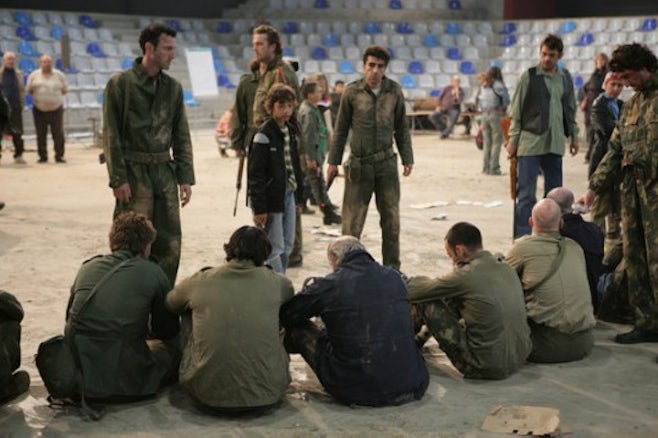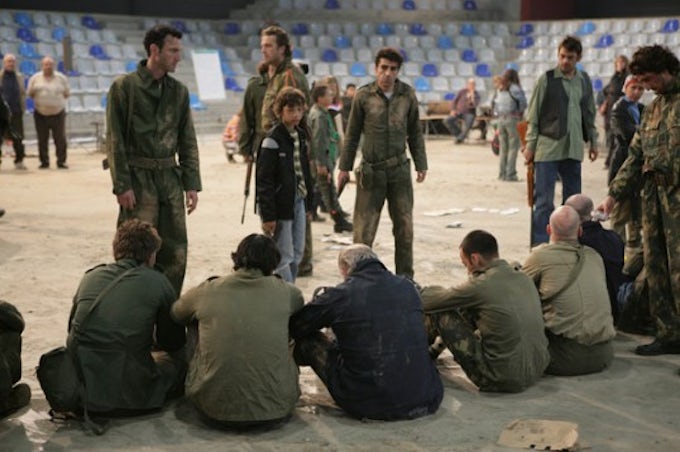
In his recent exhibition ‘Shifting Shifting’ (2006-07) at Camden Arts Centre, Aernout Mik exhibited several of his now trademark video installations: Training Ground (2006),Scapegoats(2006), Vacuum Room (2005) and Raw Footage (2006).01 As in most of his other work, Training Ground, Scapegoats and Vacuum Room are largely silent videos depicting collections of people engaged in repetitive and circular activities. The exact nature of his performers’ actions remains ambiguous, but some contextualization is provided by the use of costume, props and setting. The situation is then filmed, either from a fixed location or roaming across the scene according to some kind of internal logic. Characteristic of Mik’s work, the projection environment was designed in response to the galleries’ spaces, or (as in the case of Vacuum Room) arranged so as to produce an environment that roughly mimicked the filmed location. The screens, weighty and more substantial than practically necessary, had a sculptural materiality. Furthermore, the video technology was laid bare, with clearly visible projectors, cables and mirrors.
A common insight in much of the writing about Mik’s work is that his installations elicit a strange state in his audience, difficult to characterize as purely psychological, emotional or physical. According to this reading, a defining feature of his work is the production of two contrary dispositions in a viewer: the feeling of being both engrossed and distracted, implicated in the actions on screen and distanced by them at the same time.
We expect to consume [Mik’s] dramas and we are used to seeing action that reciprocates, displaying its expectation to be consumed. But here, it is repeatedly being offered then thwarted, as if using a perverse inversion of the Dogma manifesto.02
As in this quotation from Adam Chodzko’s essay in the leaflet published to accompany the show, this audience reaction is often linked to the narrative ambiguity of Mik’s staged situations. The videos in ‘Shifting Shifting’ depict scenarios in which two collectives appear to be in straightforward opposition, pursuing mutually exclusive goals; one set seeks to confine and order the behavior of an opposing group which is driven, in turn, to avoid this containment. In Training Ground, police marshal a group of disheveled people in what appears to be an exercise in catching and detaining illegal immigrants. Truck drivers loiter in their vehicles at the edge of the scene, suggesting they have been caught transporting illicit human cargo. But if, as the title suggests, this event is actually a rehearsal, then these truck drivers (like everyone else in the piece) are either paid extras or police officers. The immigrants are made to sit on the floor and are carefully monitored. Occasionally, there is an eruption of activity as a prisoner tries to escape or is taken ill. In Vacuum Room, young activists intervening and demonstrating at an unspecified government or trade meeting become the source of opposition and disruption. Suited men sit behind an array of bottled waters, microphones and place names at a large ring of tables. The activists invade the central space and perform a variety of actions, including a sit-in and the waving of blue and red squares of paper.

To characterise these scenarios as simply oppositional ignores their fluidity, whereby individuals gradually shift allegiance and swap roles. In Scapegoats, soldiers menace a group of civilians in a run-down sports stadium reminiscent of the New Orleans Superdome after Hurricane Katrina. However, those wielding machine guns and choreographing stress positions periodically and rather absent-mindedly cross over from perpetrator to victim. For instance, a soldier abandons his gun and in this gesture seems to lose all status, becoming vulnerable to those in his unit, who begin to (mis)treat him as a civilian. The liquid sociality of these situations undoes stable characterization, subsequently inducing in the audience movements between identification and dis-identification. This double, contradictory effect is also established by Mik’s camerawork and installation strategies, framing the constructed nature of his fictional material.
There is a novelty to Mik’s videos when considered in relation to previous incarnations of artists’ film and video, particularly that of the Structural film movement of the 1960s and 70s. Much of this work sought a singular effect, in which the audience is alienated in order to defeat or neutralize the fascination of an image. Mik does employ strategies that bear superficial resemblance to some Structural work, but he manipulates these strategies, producing very different results.
For instance, the sculptural quality of his installations, along with the unembarrassed display of video equipment, draws the audiences’ attention to the event of screening. As spectators, we are asked to focus on the physical process of producing the moving image. Similarly, the foregrounding of the actual here-and-now event of projection was a primary concern for artist film and video makers of the late 1960s. Malcolm Le Grice’s film Castle 1 (1966), for example, was accompanied by a light bulb turning on and off, periodically illuminating the projection screen and the audience and, in so doing, bleaching the film image. Valie Export’s Ping Pong(1968), as described by Malcolm Le Grice in Abstract Film and Beyond, consisted of a tennis table touching the base of a screen onto which a film showing the artist batting balls was projected. 03She would then play a live action game against herself.
Cinematography is another area in which Mik’s work comes close to some examples of Structural film. His camera trails around the location, not overly concerned with capturing the most dramatic eruptions of action. This avoidance of incident was taken to extremes in many Structural works, where a subject was recorded for extended periods of time, lingered over until all detail was entirely exhausted by the viewer’s gaze. For example, in Blind White Duration(1973), Le Grice trained his camera for a full twelve minutes on a nearly unchanging snowbound city street. This sating of visual information led to a process called ‘functional boredom’, whereby an audience’s attention moved away from the image, to an awareness of their own perceptual responses. The spectator then became conscious of the movement of his or her eyes across a screen, or the shifts in focus required to scan an image. The individual viewer’s attention moved away from the imagery, towards his or her own physical processes. This viewer, divorced from illusion and rendered self-aware, realized an almost Cartesian sense of certainty, a ground upon which he or she could fully appreciate the material conditions of the viewing situation.
For Structural filmmakers there were explicit connections between material conditions and objectivity, rationality, scientism — in a word, truth. Such thinking was influenced by that part of High Modernist discourse that proposed that an abstract painting or sculpture was objective, an actual presence, a real thing rather than a reflection or a manipulation. 04Strangely, this Modernist rhetoric fed into — and was often exchangeable with — Marxist cultural politics, which viewed conventional cinema as an instrument of bourgeois ideology. In brief, from the Marxist position, cinema is an opiate, through which the populace is permeated with fancies and fantasies that distract them from the realities of capitalist exploitation. Much experimental film and video of this period was conceived of as an antidote to mainstream cinema, exposing its fraudulent condensations of time and space.
But Mik’s work cannot be understood as an attempt to alienate a viewer in order that they may see more clearly, and the material fact of his installations is not a corrective to the seductions of video. His images attract the viewer, drawing him or her into a fictionalized world. This is not only because of the narrative cues he uses, those details of mise-en-scene or costume, for example. The scale of the screens also generates a trompe l’oeil environment, luring the viewer into the space of his videos. The projected characters are often life, or near life, sized and the spaces within the training ground, conference room and sports arena seem somehow continuous with the gallery. This continuity depends upon the positioning of the screens flush to the floor, so that as we pass by the images there is often the curious feeling of walking on the same ground as Mik’s performers.
A duality within Mik’s videos occurs on two levels. First, the spectators are made aware of the projection event, here flirting with the Structural film position, but they are also displaced into the unfolding fiction. The spectator realizes and loses his or her position within the concrete here and now. Second, rather than producing attentive, analytical, secure viewers, Mik creates distracted ones. His camera work, although predominately slow-paced, never lingers quite long enough for a spectator to feel that type of exhaustion which leads to functional boredom. Rather, Mik’s viewer approaches the threshold of tedium before the film’s editing re-orientates the scene, revealing something new.
Here I would suggest that we might look for the political effect of Mik’s work. Jacques Rancière has claimed that individuals exhibit political agency when they extract themselves from given identities and social roles. 05This can disrupt the social status quo, which is maintained through a consensual logic, or an agreement between social groups on the way that society should function. Rancière contends that the consent of these groups is bogus, because the organizing system stereotypes the people and their views. This system, termed by Rancière the ‘police’, constructs opinions based on preconceived notions of the types of people polled, and these types are built on an understanding of a person’s job, class, ethnicity or environment. But, according to Rancière, ‘there is no necessary link between who you are and the role you perform or place you occupy: no one is defined by the forms of thoughtless necessity to which they are subjected’.06 New subjects emerge through a process of dissensus, sliding between existing identities, defying the stereotype and rendering it inoperative. Mik’s distracted and displaced viewers come close to experiencing the liminal position of this political subject. They are neither in an alienated state nor immersed in narrative — they are somewhere between the two. Occupying this type of experiential lacuna does not guarantee a tangible political action, but does provide a site that escapes defined subject positions and thus offers the opportunity for political activity.
– Steve Adam Chodzko, Aernout Mik: Camden Arts Centre, File Note #18 Shifting Shifting , London: Camden Arts Centre, 2007. Klee
Footnotes
-
Adam Chodzko, Aernout Mik: Camden Arts Centre, File Note #18 Shifting Shifting, London: Camden Arts Centre, 2007.
-
Malcolm Le Grice, Abstract Film and Beyond, London: Studio Vista, 1977.
-
Rosalind Krauss, The Originality of the Avant-garde and Other Modernist Myths, Cambridge, MA and London: The MIT Press, 1985, p.10.
-
Jacques Rancière, Disagreement, Minneapolis: University of Minnesota Press, 1999, p.35.
-
Peter Hallward, ‘Staging Equality’, New Left Review , no.37, Jan-Feb 2006.
-
Ibid.
